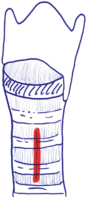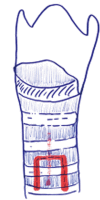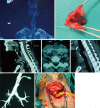Tracheotomy, closure of long-term tracheostomy and standard tracheal segmental resections
- PMID: 33209457
- PMCID: PMC7656337
- DOI: 10.21037/jtd.2020.02.41
Tracheotomy, closure of long-term tracheostomy and standard tracheal segmental resections
Abstract
Tracheotomy is a surgical procedure commonly employed to establish stable and long-term airway access. Iatrogenic airway injury post procedure may have serious consequences with limited treatment options. Tracheostoma or long standing tracheostomies require special closing techniques. Tracheotomies, tracheostomies, complications of these and treatment options, long standing tracheostomy closure techniques, and standard tracheal segmental resections are discussed.
Keywords: Tracheostomy; closure of tracheostomy; tracheal resections.
2020 Journal of Thoracic Disease. All rights reserved.
Conflict of interest statement
Conflicts of Interest: All authors have completed the ICMJE uniform disclosure form (available at http://dx.doi.org/10.21037/jtd.2020.02.41). The series “Airway Surgery” was commissioned by the editorial office without any funding or sponsorship. GA serves as the unpaid editorial board member of Journal of Thoracic Disease from Apr 2019 to Mar 2021. The other authors have no other conflicts of interest to declare.
Figures












Similar articles
-
[Reduction of Tracheotomy Associated Tracheal Stenosis by Surgical Closure of the Tracheostomy].Pneumologie. 2015 Jun;69(6):335-40. doi: 10.1055/s-0034-1391840. Epub 2015 Apr 21. Pneumologie. 2015. PMID: 25962568 German.
-
Quick Response Tracheotomy: A Novel Surgical Procedure.J Intensive Care Med. 2016 May;31(4):276-84. doi: 10.1177/0885066615627141. Epub 2016 Feb 22. J Intensive Care Med. 2016. PMID: 26905541
-
Surgical technique affects the risk for tracheostoma-related complications in post-ICU patients.Acta Otolaryngol. 2006 Dec;126(12):1303-8. doi: 10.1080/00016480600702134. Acta Otolaryngol. 2006. PMID: 17101592
-
[Percutaneous dilational tracheostomy. Indications--techniques--complications].Anaesthesist. 2005 Sep;54(9):929-41, quiz 942-3. doi: 10.1007/s00101-005-0894-2. Anaesthesist. 2005. PMID: 16091924 Review. German.
-
[Percutaneous tracheostomy].Ann Fr Anesth Reanim. 2001 Mar;20(3):260-81. doi: 10.1016/s0750-7658(00)00342-7. Ann Fr Anesth Reanim. 2001. PMID: 11332062 Review. French.
Cited by
-
Relative Factors Analysis of the Occurrence and Location of Intratracheal Granuloma Following Tracheotomy.Int J Gen Med. 2024 Dec 19;17:6355-6365. doi: 10.2147/IJGM.S493335. eCollection 2024. Int J Gen Med. 2024. PMID: 39720575 Free PMC article.
-
Impacts of long-term nasogastric tube feeding and tracheostomy on pharyngeal and laryngeal structure in ABI patients: an FEES study.Eur J Med Res. 2025 Feb 17;30(1):109. doi: 10.1186/s40001-025-02375-z. Eur J Med Res. 2025. PMID: 39962618 Free PMC article.
-
ICU nurses´ lived experience of caring for adult patients with a tracheostomy in ICU: a phenomenological-hermeneutic study.BMC Nurs. 2022 Aug 4;21(1):214. doi: 10.1186/s12912-022-01005-x. BMC Nurs. 2022. PMID: 35927677 Free PMC article.
-
Predictive Factors of Successful Decannulation in Tracheostomy Patients: A Scoping Review.J Clin Med. 2025 May 28;14(11):3798. doi: 10.3390/jcm14113798. J Clin Med. 2025. PMID: 40507559 Free PMC article. Review.
References
-
- Pierson DJ. Tracheostomy from A to Z: historical context and current challenges. Respir Care 2005;50:473-5. - PubMed
-
- Tracheotomy Jackson C.. Laryngoscope 1909;19:285-90.
-
- Durbin CG, Jr. Early complications of tracheostomy. Respir Care 2005;50:511-5. - PubMed
-
- Epstein SK. Late complications of tracheostomy. Respir Care 2005;50:542-9. - PubMed
Publication types
LinkOut - more resources
Full Text Sources
